Nursing Intervention for Mrs Y: Clinical Reasoning Cycle and Person Centered Care
VerifiedAdded on 2022/10/12
|13
|2828
|170
AI Summary
The report provides a brief clinical overview of Mrs Y who is admitted to a hospital for a fall in the morning. The three critical conditions of Mrs Y that is congestive heart failure, hypertension and high cholesterol profile was addressed by a nurse with the framework of clinical reasoning cycle. Person centered care was provided by the nurse to the patient by applying three nursing interventions. The report is concluded by gathering information about nursing strategies adopted and its implementation techniques.
Contribute Materials
Your contribution can guide someone’s learning journey. Share your
documents today.
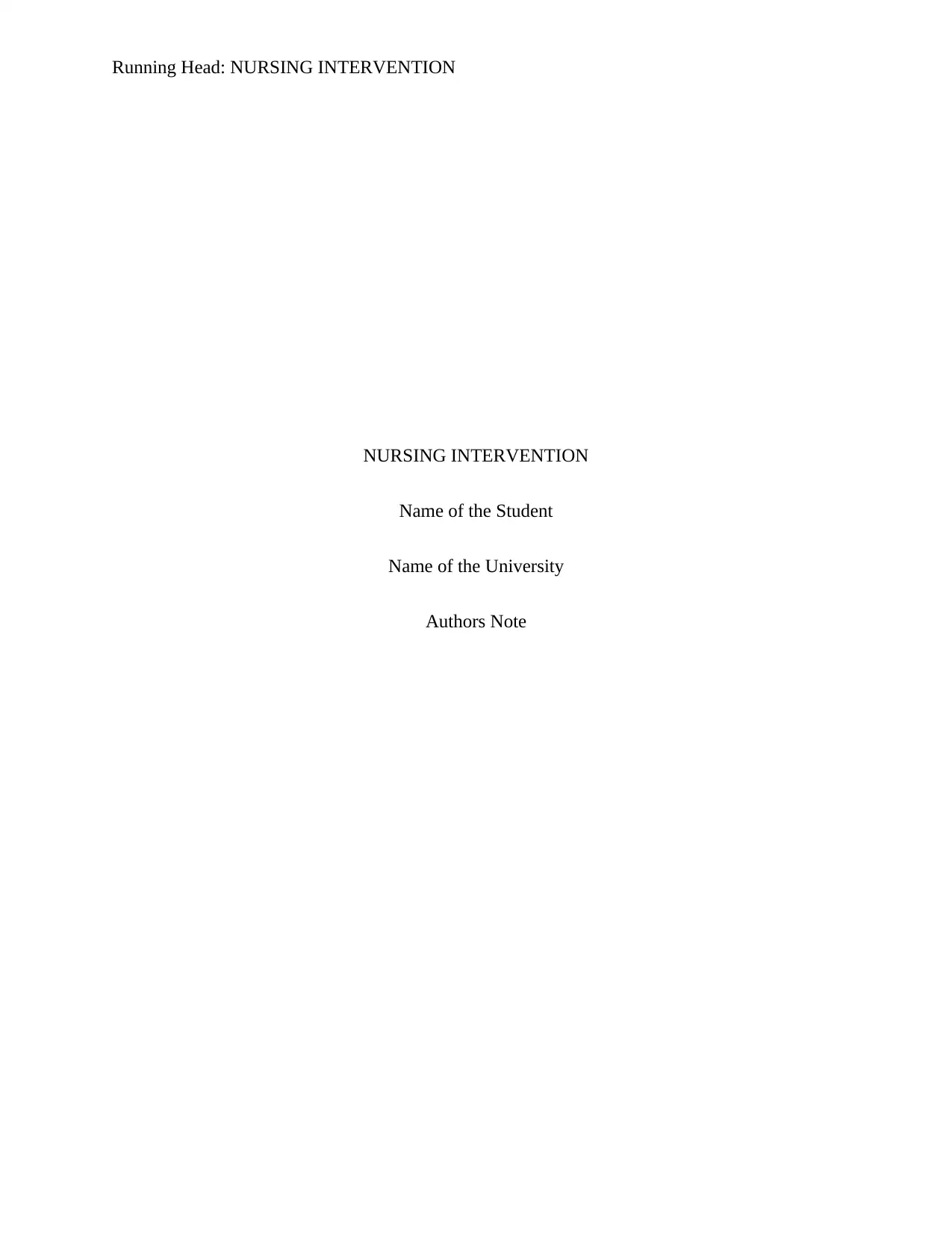
Running Head: NURSING INTERVENTION
NURSING INTERVENTION
Name of the Student
Name of the University
Authors Note
NURSING INTERVENTION
Name of the Student
Name of the University
Authors Note
Secure Best Marks with AI Grader
Need help grading? Try our AI Grader for instant feedback on your assignments.
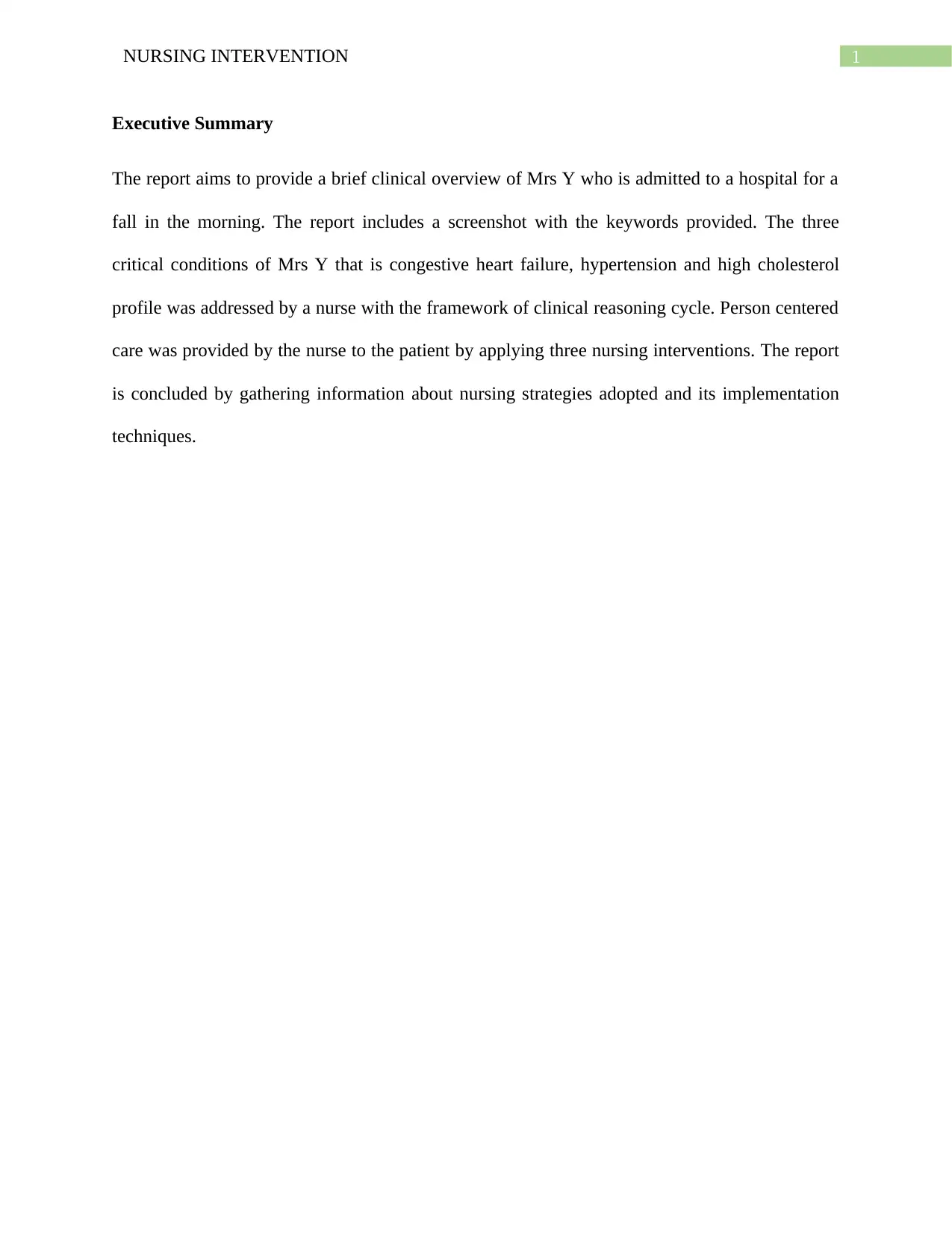
1NURSING INTERVENTION
Executive Summary
The report aims to provide a brief clinical overview of Mrs Y who is admitted to a hospital for a
fall in the morning. The report includes a screenshot with the keywords provided. The three
critical conditions of Mrs Y that is congestive heart failure, hypertension and high cholesterol
profile was addressed by a nurse with the framework of clinical reasoning cycle. Person centered
care was provided by the nurse to the patient by applying three nursing interventions. The report
is concluded by gathering information about nursing strategies adopted and its implementation
techniques.
Executive Summary
The report aims to provide a brief clinical overview of Mrs Y who is admitted to a hospital for a
fall in the morning. The report includes a screenshot with the keywords provided. The three
critical conditions of Mrs Y that is congestive heart failure, hypertension and high cholesterol
profile was addressed by a nurse with the framework of clinical reasoning cycle. Person centered
care was provided by the nurse to the patient by applying three nursing interventions. The report
is concluded by gathering information about nursing strategies adopted and its implementation
techniques.
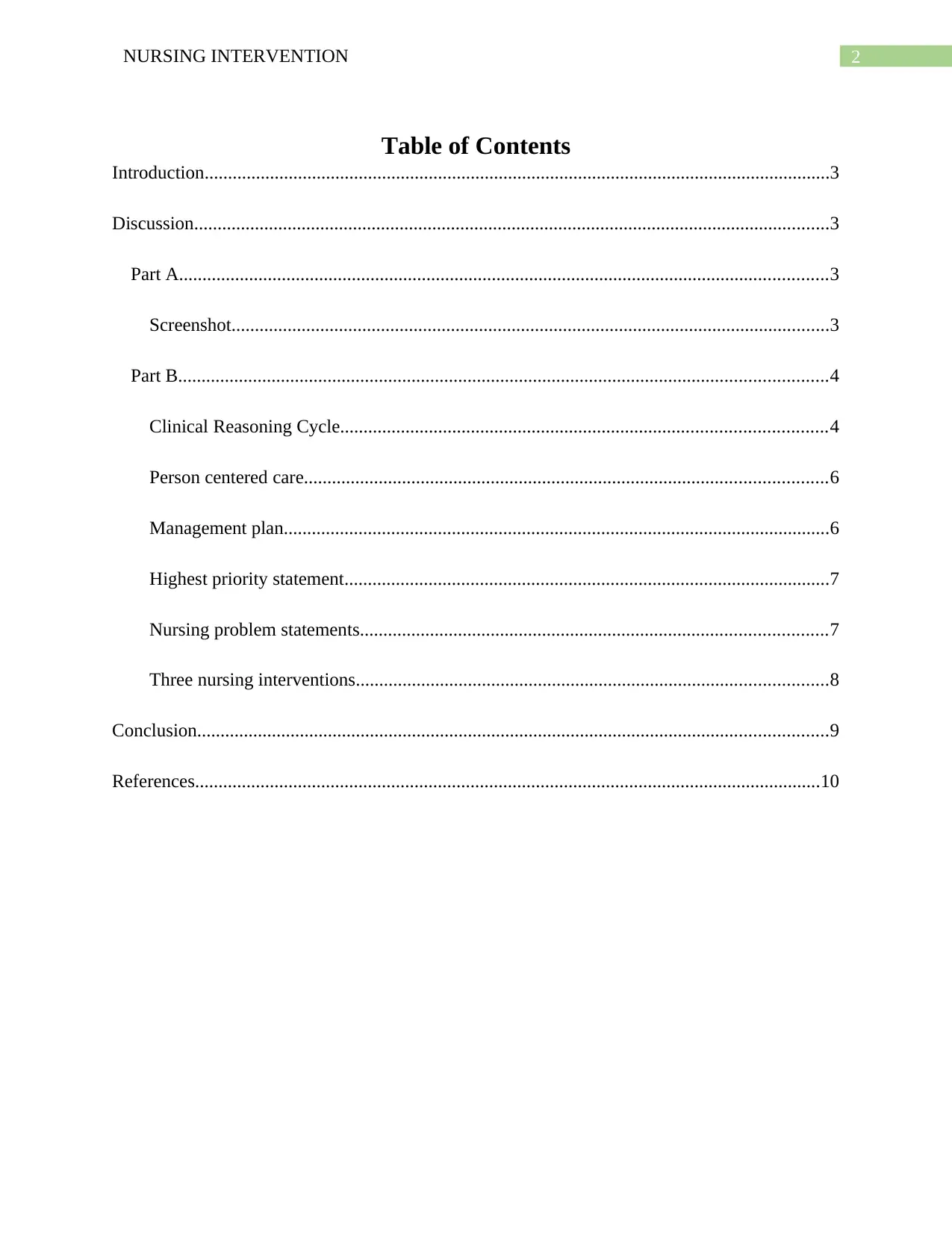
2NURSING INTERVENTION
Table of Contents
Introduction......................................................................................................................................3
Discussion........................................................................................................................................3
Part A...........................................................................................................................................3
Screenshot................................................................................................................................3
Part B...........................................................................................................................................4
Clinical Reasoning Cycle........................................................................................................4
Person centered care................................................................................................................6
Management plan.....................................................................................................................6
Highest priority statement........................................................................................................7
Nursing problem statements....................................................................................................7
Three nursing interventions.....................................................................................................8
Conclusion.......................................................................................................................................9
References......................................................................................................................................10
Table of Contents
Introduction......................................................................................................................................3
Discussion........................................................................................................................................3
Part A...........................................................................................................................................3
Screenshot................................................................................................................................3
Part B...........................................................................................................................................4
Clinical Reasoning Cycle........................................................................................................4
Person centered care................................................................................................................6
Management plan.....................................................................................................................6
Highest priority statement........................................................................................................7
Nursing problem statements....................................................................................................7
Three nursing interventions.....................................................................................................8
Conclusion.......................................................................................................................................9
References......................................................................................................................................10
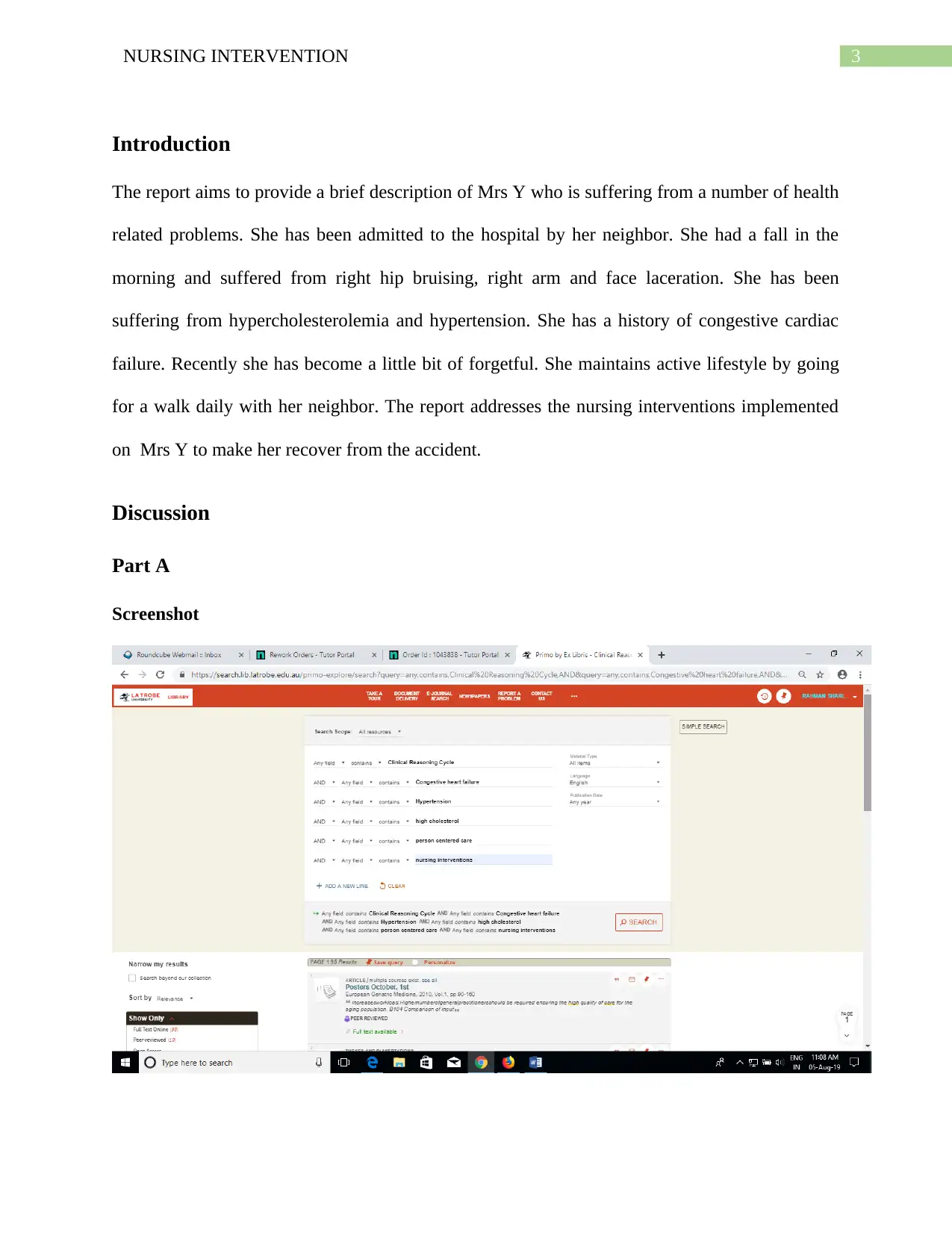
3NURSING INTERVENTION
Introduction
The report aims to provide a brief description of Mrs Y who is suffering from a number of health
related problems. She has been admitted to the hospital by her neighbor. She had a fall in the
morning and suffered from right hip bruising, right arm and face laceration. She has been
suffering from hypercholesterolemia and hypertension. She has a history of congestive cardiac
failure. Recently she has become a little bit of forgetful. She maintains active lifestyle by going
for a walk daily with her neighbor. The report addresses the nursing interventions implemented
on Mrs Y to make her recover from the accident.
Discussion
Part A
Screenshot
Introduction
The report aims to provide a brief description of Mrs Y who is suffering from a number of health
related problems. She has been admitted to the hospital by her neighbor. She had a fall in the
morning and suffered from right hip bruising, right arm and face laceration. She has been
suffering from hypercholesterolemia and hypertension. She has a history of congestive cardiac
failure. Recently she has become a little bit of forgetful. She maintains active lifestyle by going
for a walk daily with her neighbor. The report addresses the nursing interventions implemented
on Mrs Y to make her recover from the accident.
Discussion
Part A
Screenshot
Secure Best Marks with AI Grader
Need help grading? Try our AI Grader for instant feedback on your assignments.
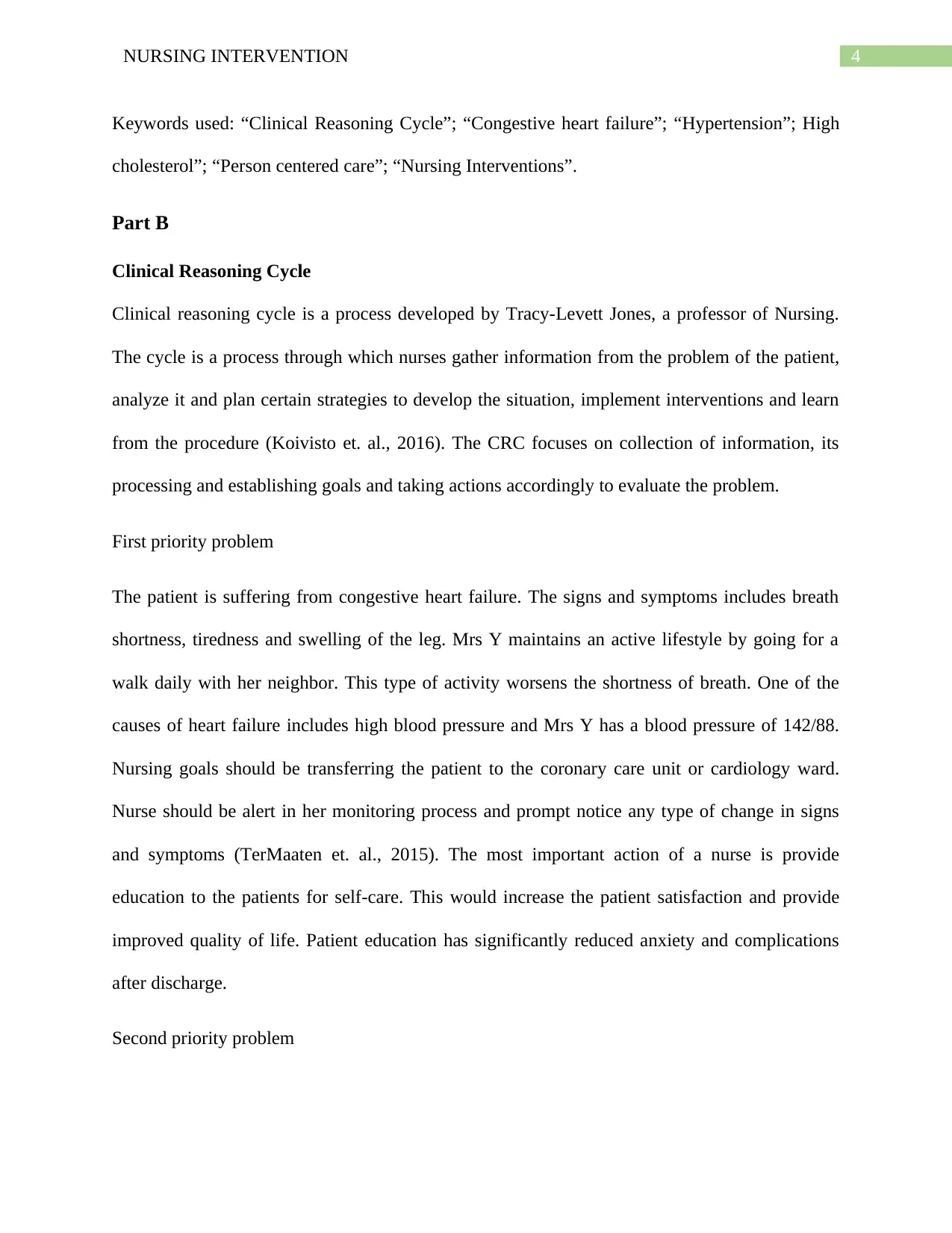
4NURSING INTERVENTION
Keywords used: “Clinical Reasoning Cycle”; “Congestive heart failure”; “Hypertension”; High
cholesterol”; “Person centered care”; “Nursing Interventions”.
Part B
Clinical Reasoning Cycle
Clinical reasoning cycle is a process developed by Tracy-Levett Jones, a professor of Nursing.
The cycle is a process through which nurses gather information from the problem of the patient,
analyze it and plan certain strategies to develop the situation, implement interventions and learn
from the procedure (Koivisto et. al., 2016). The CRC focuses on collection of information, its
processing and establishing goals and taking actions accordingly to evaluate the problem.
First priority problem
The patient is suffering from congestive heart failure. The signs and symptoms includes breath
shortness, tiredness and swelling of the leg. Mrs Y maintains an active lifestyle by going for a
walk daily with her neighbor. This type of activity worsens the shortness of breath. One of the
causes of heart failure includes high blood pressure and Mrs Y has a blood pressure of 142/88.
Nursing goals should be transferring the patient to the coronary care unit or cardiology ward.
Nurse should be alert in her monitoring process and prompt notice any type of change in signs
and symptoms (TerMaaten et. al., 2015). The most important action of a nurse is provide
education to the patients for self-care. This would increase the patient satisfaction and provide
improved quality of life. Patient education has significantly reduced anxiety and complications
after discharge.
Second priority problem
Keywords used: “Clinical Reasoning Cycle”; “Congestive heart failure”; “Hypertension”; High
cholesterol”; “Person centered care”; “Nursing Interventions”.
Part B
Clinical Reasoning Cycle
Clinical reasoning cycle is a process developed by Tracy-Levett Jones, a professor of Nursing.
The cycle is a process through which nurses gather information from the problem of the patient,
analyze it and plan certain strategies to develop the situation, implement interventions and learn
from the procedure (Koivisto et. al., 2016). The CRC focuses on collection of information, its
processing and establishing goals and taking actions accordingly to evaluate the problem.
First priority problem
The patient is suffering from congestive heart failure. The signs and symptoms includes breath
shortness, tiredness and swelling of the leg. Mrs Y maintains an active lifestyle by going for a
walk daily with her neighbor. This type of activity worsens the shortness of breath. One of the
causes of heart failure includes high blood pressure and Mrs Y has a blood pressure of 142/88.
Nursing goals should be transferring the patient to the coronary care unit or cardiology ward.
Nurse should be alert in her monitoring process and prompt notice any type of change in signs
and symptoms (TerMaaten et. al., 2015). The most important action of a nurse is provide
education to the patients for self-care. This would increase the patient satisfaction and provide
improved quality of life. Patient education has significantly reduced anxiety and complications
after discharge.
Second priority problem
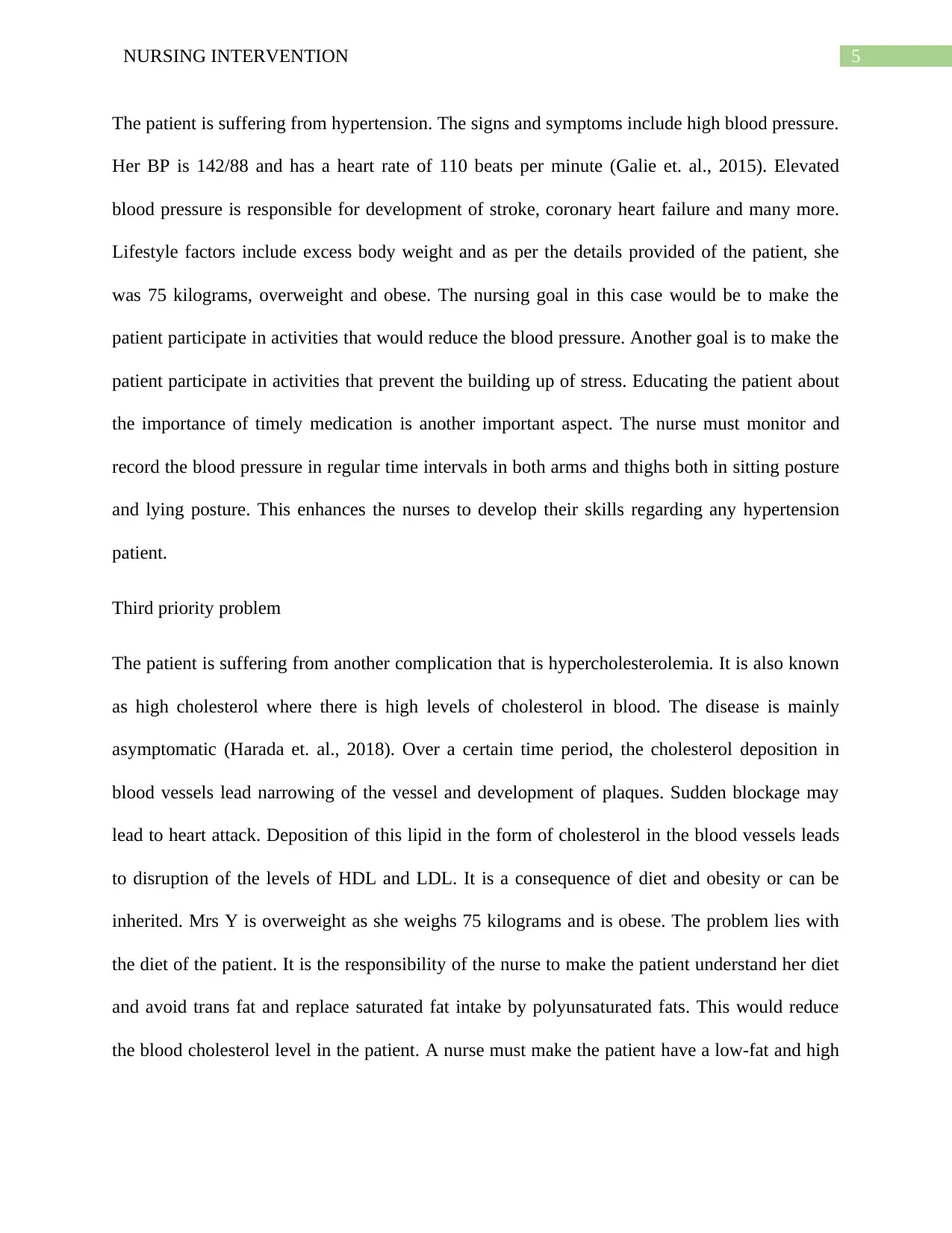
5NURSING INTERVENTION
The patient is suffering from hypertension. The signs and symptoms include high blood pressure.
Her BP is 142/88 and has a heart rate of 110 beats per minute (Galie et. al., 2015). Elevated
blood pressure is responsible for development of stroke, coronary heart failure and many more.
Lifestyle factors include excess body weight and as per the details provided of the patient, she
was 75 kilograms, overweight and obese. The nursing goal in this case would be to make the
patient participate in activities that would reduce the blood pressure. Another goal is to make the
patient participate in activities that prevent the building up of stress. Educating the patient about
the importance of timely medication is another important aspect. The nurse must monitor and
record the blood pressure in regular time intervals in both arms and thighs both in sitting posture
and lying posture. This enhances the nurses to develop their skills regarding any hypertension
patient.
Third priority problem
The patient is suffering from another complication that is hypercholesterolemia. It is also known
as high cholesterol where there is high levels of cholesterol in blood. The disease is mainly
asymptomatic (Harada et. al., 2018). Over a certain time period, the cholesterol deposition in
blood vessels lead narrowing of the vessel and development of plaques. Sudden blockage may
lead to heart attack. Deposition of this lipid in the form of cholesterol in the blood vessels leads
to disruption of the levels of HDL and LDL. It is a consequence of diet and obesity or can be
inherited. Mrs Y is overweight as she weighs 75 kilograms and is obese. The problem lies with
the diet of the patient. It is the responsibility of the nurse to make the patient understand her diet
and avoid trans fat and replace saturated fat intake by polyunsaturated fats. This would reduce
the blood cholesterol level in the patient. A nurse must make the patient have a low-fat and high
The patient is suffering from hypertension. The signs and symptoms include high blood pressure.
Her BP is 142/88 and has a heart rate of 110 beats per minute (Galie et. al., 2015). Elevated
blood pressure is responsible for development of stroke, coronary heart failure and many more.
Lifestyle factors include excess body weight and as per the details provided of the patient, she
was 75 kilograms, overweight and obese. The nursing goal in this case would be to make the
patient participate in activities that would reduce the blood pressure. Another goal is to make the
patient participate in activities that prevent the building up of stress. Educating the patient about
the importance of timely medication is another important aspect. The nurse must monitor and
record the blood pressure in regular time intervals in both arms and thighs both in sitting posture
and lying posture. This enhances the nurses to develop their skills regarding any hypertension
patient.
Third priority problem
The patient is suffering from another complication that is hypercholesterolemia. It is also known
as high cholesterol where there is high levels of cholesterol in blood. The disease is mainly
asymptomatic (Harada et. al., 2018). Over a certain time period, the cholesterol deposition in
blood vessels lead narrowing of the vessel and development of plaques. Sudden blockage may
lead to heart attack. Deposition of this lipid in the form of cholesterol in the blood vessels leads
to disruption of the levels of HDL and LDL. It is a consequence of diet and obesity or can be
inherited. Mrs Y is overweight as she weighs 75 kilograms and is obese. The problem lies with
the diet of the patient. It is the responsibility of the nurse to make the patient understand her diet
and avoid trans fat and replace saturated fat intake by polyunsaturated fats. This would reduce
the blood cholesterol level in the patient. A nurse must make the patient have a low-fat and high
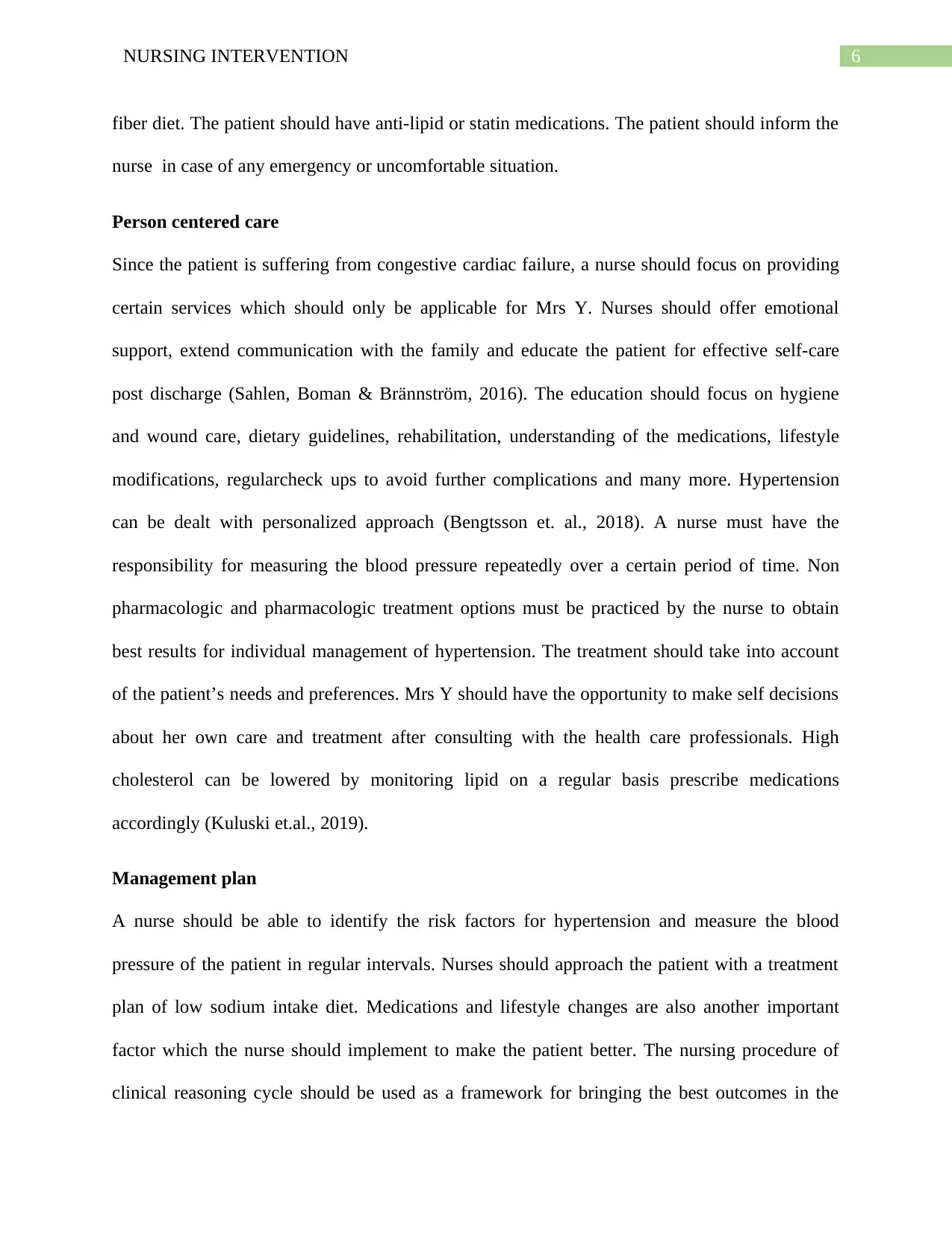
6NURSING INTERVENTION
fiber diet. The patient should have anti-lipid or statin medications. The patient should inform the
nurse in case of any emergency or uncomfortable situation.
Person centered care
Since the patient is suffering from congestive cardiac failure, a nurse should focus on providing
certain services which should only be applicable for Mrs Y. Nurses should offer emotional
support, extend communication with the family and educate the patient for effective self-care
post discharge (Sahlen, Boman & Brännström, 2016). The education should focus on hygiene
and wound care, dietary guidelines, rehabilitation, understanding of the medications, lifestyle
modifications, regularcheck ups to avoid further complications and many more. Hypertension
can be dealt with personalized approach (Bengtsson et. al., 2018). A nurse must have the
responsibility for measuring the blood pressure repeatedly over a certain period of time. Non
pharmacologic and pharmacologic treatment options must be practiced by the nurse to obtain
best results for individual management of hypertension. The treatment should take into account
of the patient’s needs and preferences. Mrs Y should have the opportunity to make self decisions
about her own care and treatment after consulting with the health care professionals. High
cholesterol can be lowered by monitoring lipid on a regular basis prescribe medications
accordingly (Kuluski et.al., 2019).
Management plan
A nurse should be able to identify the risk factors for hypertension and measure the blood
pressure of the patient in regular intervals. Nurses should approach the patient with a treatment
plan of low sodium intake diet. Medications and lifestyle changes are also another important
factor which the nurse should implement to make the patient better. The nursing procedure of
clinical reasoning cycle should be used as a framework for bringing the best outcomes in the
fiber diet. The patient should have anti-lipid or statin medications. The patient should inform the
nurse in case of any emergency or uncomfortable situation.
Person centered care
Since the patient is suffering from congestive cardiac failure, a nurse should focus on providing
certain services which should only be applicable for Mrs Y. Nurses should offer emotional
support, extend communication with the family and educate the patient for effective self-care
post discharge (Sahlen, Boman & Brännström, 2016). The education should focus on hygiene
and wound care, dietary guidelines, rehabilitation, understanding of the medications, lifestyle
modifications, regularcheck ups to avoid further complications and many more. Hypertension
can be dealt with personalized approach (Bengtsson et. al., 2018). A nurse must have the
responsibility for measuring the blood pressure repeatedly over a certain period of time. Non
pharmacologic and pharmacologic treatment options must be practiced by the nurse to obtain
best results for individual management of hypertension. The treatment should take into account
of the patient’s needs and preferences. Mrs Y should have the opportunity to make self decisions
about her own care and treatment after consulting with the health care professionals. High
cholesterol can be lowered by monitoring lipid on a regular basis prescribe medications
accordingly (Kuluski et.al., 2019).
Management plan
A nurse should be able to identify the risk factors for hypertension and measure the blood
pressure of the patient in regular intervals. Nurses should approach the patient with a treatment
plan of low sodium intake diet. Medications and lifestyle changes are also another important
factor which the nurse should implement to make the patient better. The nursing procedure of
clinical reasoning cycle should be used as a framework for bringing the best outcomes in the
Paraphrase This Document
Need a fresh take? Get an instant paraphrase of this document with our AI Paraphraser
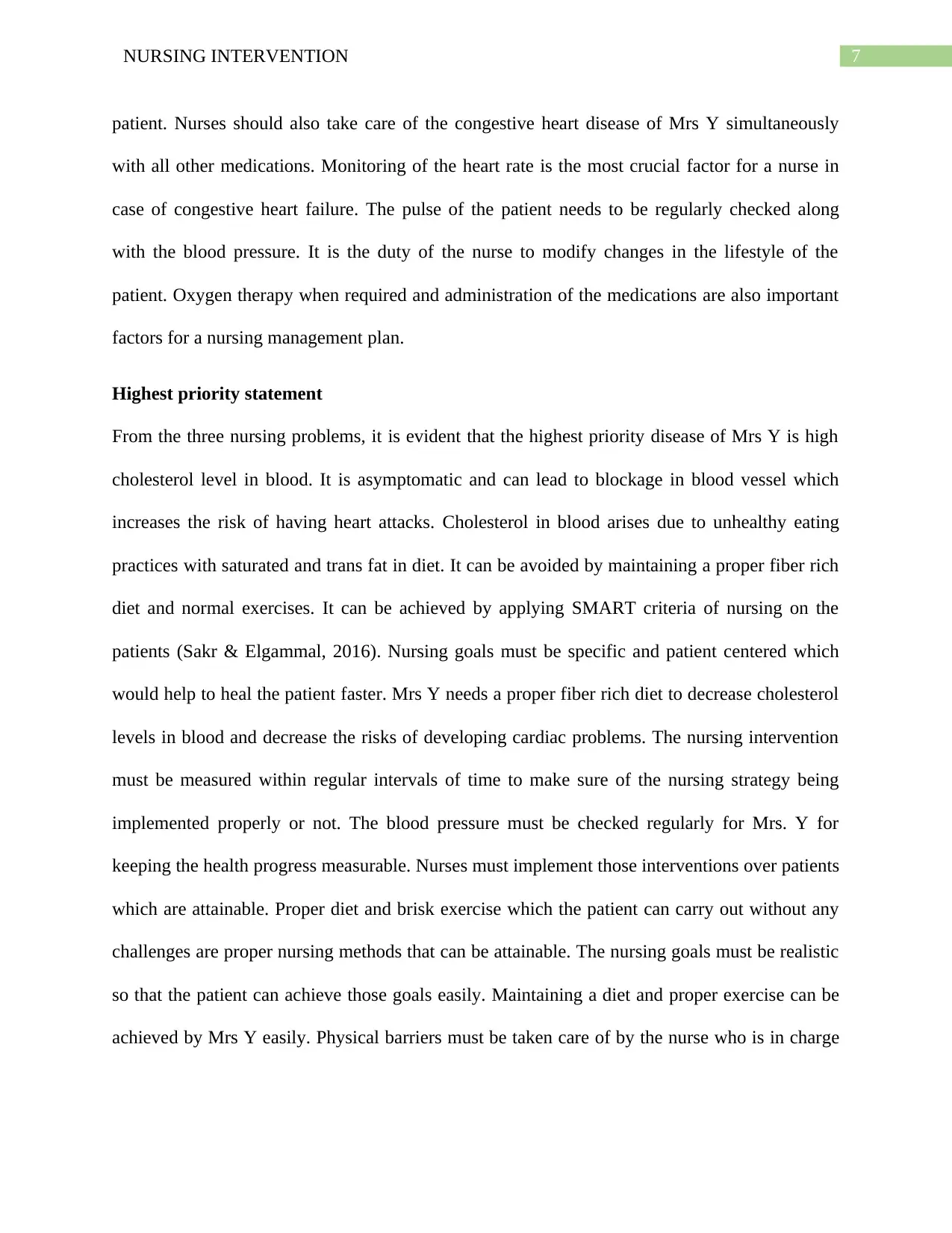
7NURSING INTERVENTION
patient. Nurses should also take care of the congestive heart disease of Mrs Y simultaneously
with all other medications. Monitoring of the heart rate is the most crucial factor for a nurse in
case of congestive heart failure. The pulse of the patient needs to be regularly checked along
with the blood pressure. It is the duty of the nurse to modify changes in the lifestyle of the
patient. Oxygen therapy when required and administration of the medications are also important
factors for a nursing management plan.
Highest priority statement
From the three nursing problems, it is evident that the highest priority disease of Mrs Y is high
cholesterol level in blood. It is asymptomatic and can lead to blockage in blood vessel which
increases the risk of having heart attacks. Cholesterol in blood arises due to unhealthy eating
practices with saturated and trans fat in diet. It can be avoided by maintaining a proper fiber rich
diet and normal exercises. It can be achieved by applying SMART criteria of nursing on the
patients (Sakr & Elgammal, 2016). Nursing goals must be specific and patient centered which
would help to heal the patient faster. Mrs Y needs a proper fiber rich diet to decrease cholesterol
levels in blood and decrease the risks of developing cardiac problems. The nursing intervention
must be measured within regular intervals of time to make sure of the nursing strategy being
implemented properly or not. The blood pressure must be checked regularly for Mrs. Y for
keeping the health progress measurable. Nurses must implement those interventions over patients
which are attainable. Proper diet and brisk exercise which the patient can carry out without any
challenges are proper nursing methods that can be attainable. The nursing goals must be realistic
so that the patient can achieve those goals easily. Maintaining a diet and proper exercise can be
achieved by Mrs Y easily. Physical barriers must be taken care of by the nurse who is in charge
patient. Nurses should also take care of the congestive heart disease of Mrs Y simultaneously
with all other medications. Monitoring of the heart rate is the most crucial factor for a nurse in
case of congestive heart failure. The pulse of the patient needs to be regularly checked along
with the blood pressure. It is the duty of the nurse to modify changes in the lifestyle of the
patient. Oxygen therapy when required and administration of the medications are also important
factors for a nursing management plan.
Highest priority statement
From the three nursing problems, it is evident that the highest priority disease of Mrs Y is high
cholesterol level in blood. It is asymptomatic and can lead to blockage in blood vessel which
increases the risk of having heart attacks. Cholesterol in blood arises due to unhealthy eating
practices with saturated and trans fat in diet. It can be avoided by maintaining a proper fiber rich
diet and normal exercises. It can be achieved by applying SMART criteria of nursing on the
patients (Sakr & Elgammal, 2016). Nursing goals must be specific and patient centered which
would help to heal the patient faster. Mrs Y needs a proper fiber rich diet to decrease cholesterol
levels in blood and decrease the risks of developing cardiac problems. The nursing intervention
must be measured within regular intervals of time to make sure of the nursing strategy being
implemented properly or not. The blood pressure must be checked regularly for Mrs. Y for
keeping the health progress measurable. Nurses must implement those interventions over patients
which are attainable. Proper diet and brisk exercise which the patient can carry out without any
challenges are proper nursing methods that can be attainable. The nursing goals must be realistic
so that the patient can achieve those goals easily. Maintaining a diet and proper exercise can be
achieved by Mrs Y easily. Physical barriers must be taken care of by the nurse who is in charge
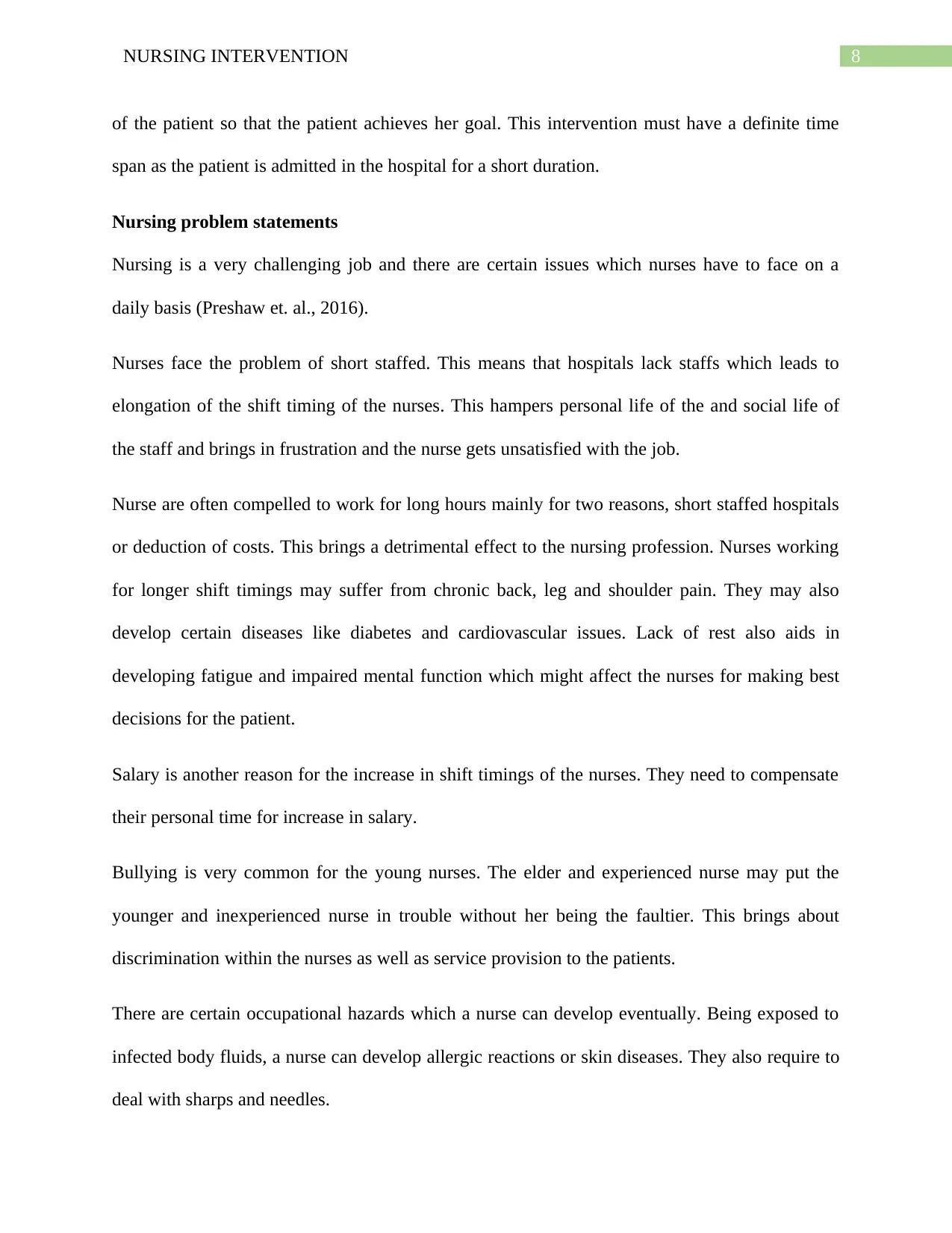
8NURSING INTERVENTION
of the patient so that the patient achieves her goal. This intervention must have a definite time
span as the patient is admitted in the hospital for a short duration.
Nursing problem statements
Nursing is a very challenging job and there are certain issues which nurses have to face on a
daily basis (Preshaw et. al., 2016).
Nurses face the problem of short staffed. This means that hospitals lack staffs which leads to
elongation of the shift timing of the nurses. This hampers personal life of the and social life of
the staff and brings in frustration and the nurse gets unsatisfied with the job.
Nurse are often compelled to work for long hours mainly for two reasons, short staffed hospitals
or deduction of costs. This brings a detrimental effect to the nursing profession. Nurses working
for longer shift timings may suffer from chronic back, leg and shoulder pain. They may also
develop certain diseases like diabetes and cardiovascular issues. Lack of rest also aids in
developing fatigue and impaired mental function which might affect the nurses for making best
decisions for the patient.
Salary is another reason for the increase in shift timings of the nurses. They need to compensate
their personal time for increase in salary.
Bullying is very common for the young nurses. The elder and experienced nurse may put the
younger and inexperienced nurse in trouble without her being the faultier. This brings about
discrimination within the nurses as well as service provision to the patients.
There are certain occupational hazards which a nurse can develop eventually. Being exposed to
infected body fluids, a nurse can develop allergic reactions or skin diseases. They also require to
deal with sharps and needles.
of the patient so that the patient achieves her goal. This intervention must have a definite time
span as the patient is admitted in the hospital for a short duration.
Nursing problem statements
Nursing is a very challenging job and there are certain issues which nurses have to face on a
daily basis (Preshaw et. al., 2016).
Nurses face the problem of short staffed. This means that hospitals lack staffs which leads to
elongation of the shift timing of the nurses. This hampers personal life of the and social life of
the staff and brings in frustration and the nurse gets unsatisfied with the job.
Nurse are often compelled to work for long hours mainly for two reasons, short staffed hospitals
or deduction of costs. This brings a detrimental effect to the nursing profession. Nurses working
for longer shift timings may suffer from chronic back, leg and shoulder pain. They may also
develop certain diseases like diabetes and cardiovascular issues. Lack of rest also aids in
developing fatigue and impaired mental function which might affect the nurses for making best
decisions for the patient.
Salary is another reason for the increase in shift timings of the nurses. They need to compensate
their personal time for increase in salary.
Bullying is very common for the young nurses. The elder and experienced nurse may put the
younger and inexperienced nurse in trouble without her being the faultier. This brings about
discrimination within the nurses as well as service provision to the patients.
There are certain occupational hazards which a nurse can develop eventually. Being exposed to
infected body fluids, a nurse can develop allergic reactions or skin diseases. They also require to
deal with sharps and needles.
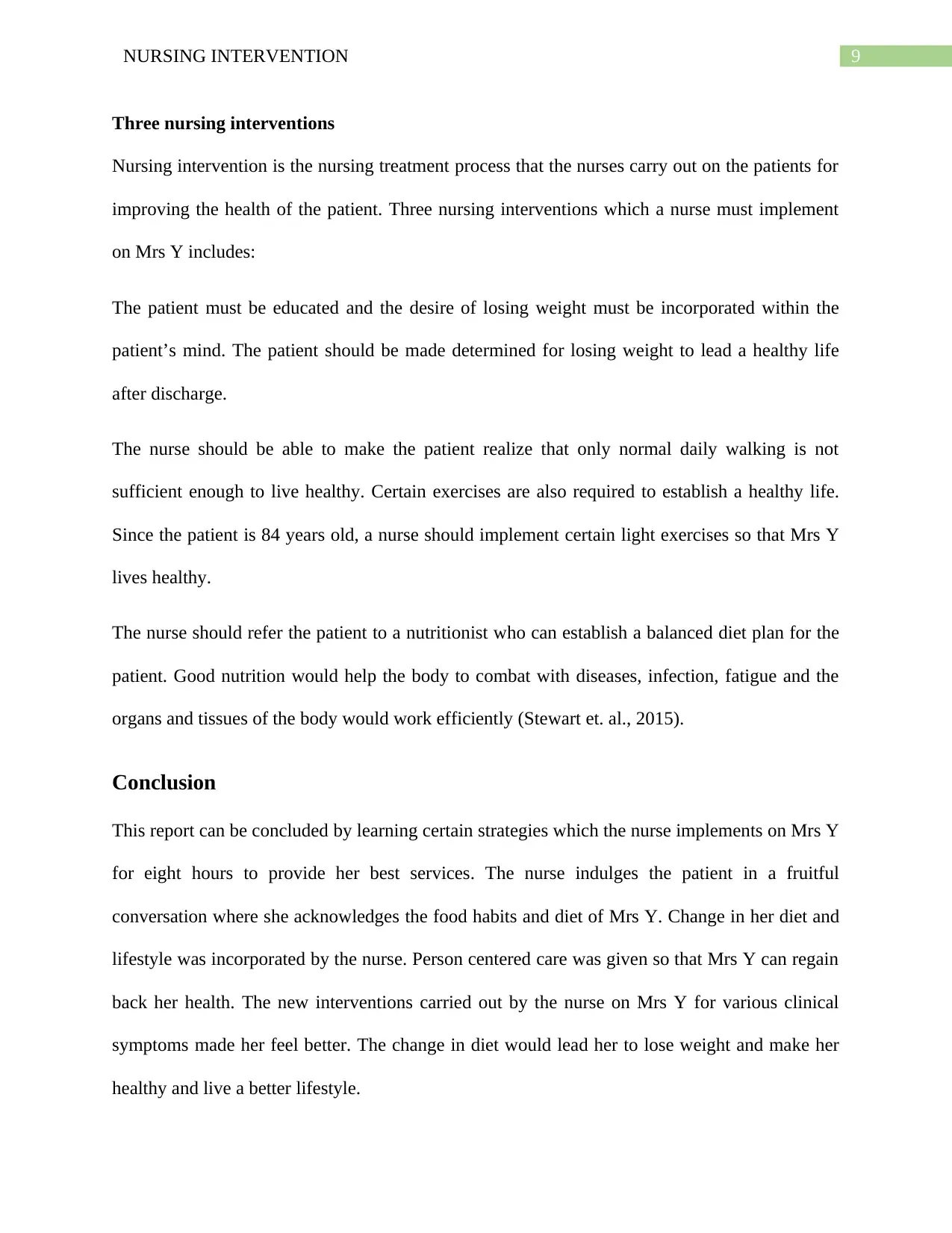
9NURSING INTERVENTION
Three nursing interventions
Nursing intervention is the nursing treatment process that the nurses carry out on the patients for
improving the health of the patient. Three nursing interventions which a nurse must implement
on Mrs Y includes:
The patient must be educated and the desire of losing weight must be incorporated within the
patient’s mind. The patient should be made determined for losing weight to lead a healthy life
after discharge.
The nurse should be able to make the patient realize that only normal daily walking is not
sufficient enough to live healthy. Certain exercises are also required to establish a healthy life.
Since the patient is 84 years old, a nurse should implement certain light exercises so that Mrs Y
lives healthy.
The nurse should refer the patient to a nutritionist who can establish a balanced diet plan for the
patient. Good nutrition would help the body to combat with diseases, infection, fatigue and the
organs and tissues of the body would work efficiently (Stewart et. al., 2015).
Conclusion
This report can be concluded by learning certain strategies which the nurse implements on Mrs Y
for eight hours to provide her best services. The nurse indulges the patient in a fruitful
conversation where she acknowledges the food habits and diet of Mrs Y. Change in her diet and
lifestyle was incorporated by the nurse. Person centered care was given so that Mrs Y can regain
back her health. The new interventions carried out by the nurse on Mrs Y for various clinical
symptoms made her feel better. The change in diet would lead her to lose weight and make her
healthy and live a better lifestyle.
Three nursing interventions
Nursing intervention is the nursing treatment process that the nurses carry out on the patients for
improving the health of the patient. Three nursing interventions which a nurse must implement
on Mrs Y includes:
The patient must be educated and the desire of losing weight must be incorporated within the
patient’s mind. The patient should be made determined for losing weight to lead a healthy life
after discharge.
The nurse should be able to make the patient realize that only normal daily walking is not
sufficient enough to live healthy. Certain exercises are also required to establish a healthy life.
Since the patient is 84 years old, a nurse should implement certain light exercises so that Mrs Y
lives healthy.
The nurse should refer the patient to a nutritionist who can establish a balanced diet plan for the
patient. Good nutrition would help the body to combat with diseases, infection, fatigue and the
organs and tissues of the body would work efficiently (Stewart et. al., 2015).
Conclusion
This report can be concluded by learning certain strategies which the nurse implements on Mrs Y
for eight hours to provide her best services. The nurse indulges the patient in a fruitful
conversation where she acknowledges the food habits and diet of Mrs Y. Change in her diet and
lifestyle was incorporated by the nurse. Person centered care was given so that Mrs Y can regain
back her health. The new interventions carried out by the nurse on Mrs Y for various clinical
symptoms made her feel better. The change in diet would lead her to lose weight and make her
healthy and live a better lifestyle.
Secure Best Marks with AI Grader
Need help grading? Try our AI Grader for instant feedback on your assignments.
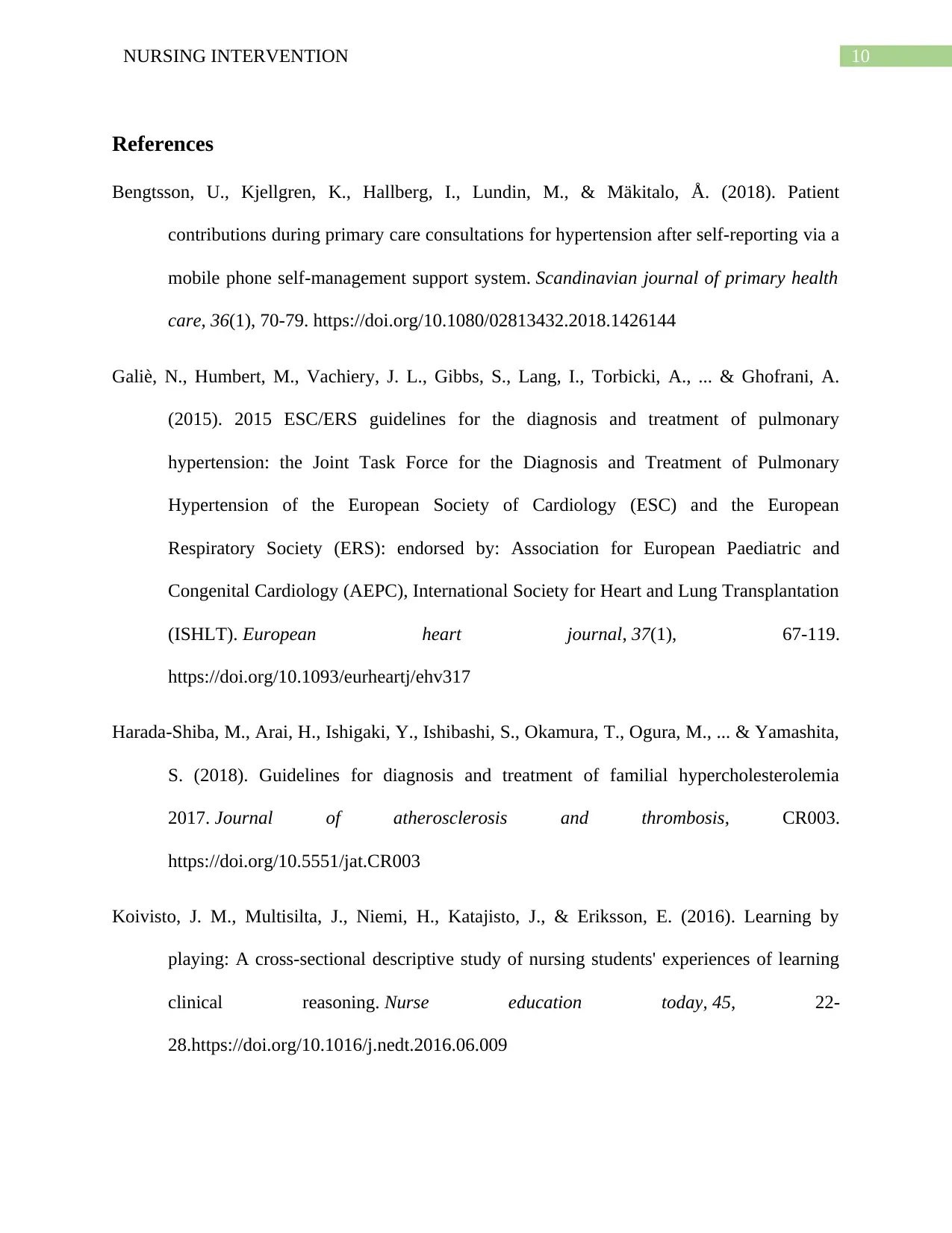
10NURSING INTERVENTION
References
Bengtsson, U., Kjellgren, K., Hallberg, I., Lundin, M., & Mäkitalo, Å. (2018). Patient
contributions during primary care consultations for hypertension after self-reporting via a
mobile phone self-management support system. Scandinavian journal of primary health
care, 36(1), 70-79. https://doi.org/10.1080/02813432.2018.1426144
Galiè, N., Humbert, M., Vachiery, J. L., Gibbs, S., Lang, I., Torbicki, A., ... & Ghofrani, A.
(2015). 2015 ESC/ERS guidelines for the diagnosis and treatment of pulmonary
hypertension: the Joint Task Force for the Diagnosis and Treatment of Pulmonary
Hypertension of the European Society of Cardiology (ESC) and the European
Respiratory Society (ERS): endorsed by: Association for European Paediatric and
Congenital Cardiology (AEPC), International Society for Heart and Lung Transplantation
(ISHLT). European heart journal, 37(1), 67-119.
https://doi.org/10.1093/eurheartj/ehv317
Harada-Shiba, M., Arai, H., Ishigaki, Y., Ishibashi, S., Okamura, T., Ogura, M., ... & Yamashita,
S. (2018). Guidelines for diagnosis and treatment of familial hypercholesterolemia
2017. Journal of atherosclerosis and thrombosis, CR003.
https://doi.org/10.5551/jat.CR003
Koivisto, J. M., Multisilta, J., Niemi, H., Katajisto, J., & Eriksson, E. (2016). Learning by
playing: A cross-sectional descriptive study of nursing students' experiences of learning
clinical reasoning. Nurse education today, 45, 22-
28.https://doi.org/10.1016/j.nedt.2016.06.009
References
Bengtsson, U., Kjellgren, K., Hallberg, I., Lundin, M., & Mäkitalo, Å. (2018). Patient
contributions during primary care consultations for hypertension after self-reporting via a
mobile phone self-management support system. Scandinavian journal of primary health
care, 36(1), 70-79. https://doi.org/10.1080/02813432.2018.1426144
Galiè, N., Humbert, M., Vachiery, J. L., Gibbs, S., Lang, I., Torbicki, A., ... & Ghofrani, A.
(2015). 2015 ESC/ERS guidelines for the diagnosis and treatment of pulmonary
hypertension: the Joint Task Force for the Diagnosis and Treatment of Pulmonary
Hypertension of the European Society of Cardiology (ESC) and the European
Respiratory Society (ERS): endorsed by: Association for European Paediatric and
Congenital Cardiology (AEPC), International Society for Heart and Lung Transplantation
(ISHLT). European heart journal, 37(1), 67-119.
https://doi.org/10.1093/eurheartj/ehv317
Harada-Shiba, M., Arai, H., Ishigaki, Y., Ishibashi, S., Okamura, T., Ogura, M., ... & Yamashita,
S. (2018). Guidelines for diagnosis and treatment of familial hypercholesterolemia
2017. Journal of atherosclerosis and thrombosis, CR003.
https://doi.org/10.5551/jat.CR003
Koivisto, J. M., Multisilta, J., Niemi, H., Katajisto, J., & Eriksson, E. (2016). Learning by
playing: A cross-sectional descriptive study of nursing students' experiences of learning
clinical reasoning. Nurse education today, 45, 22-
28.https://doi.org/10.1016/j.nedt.2016.06.009
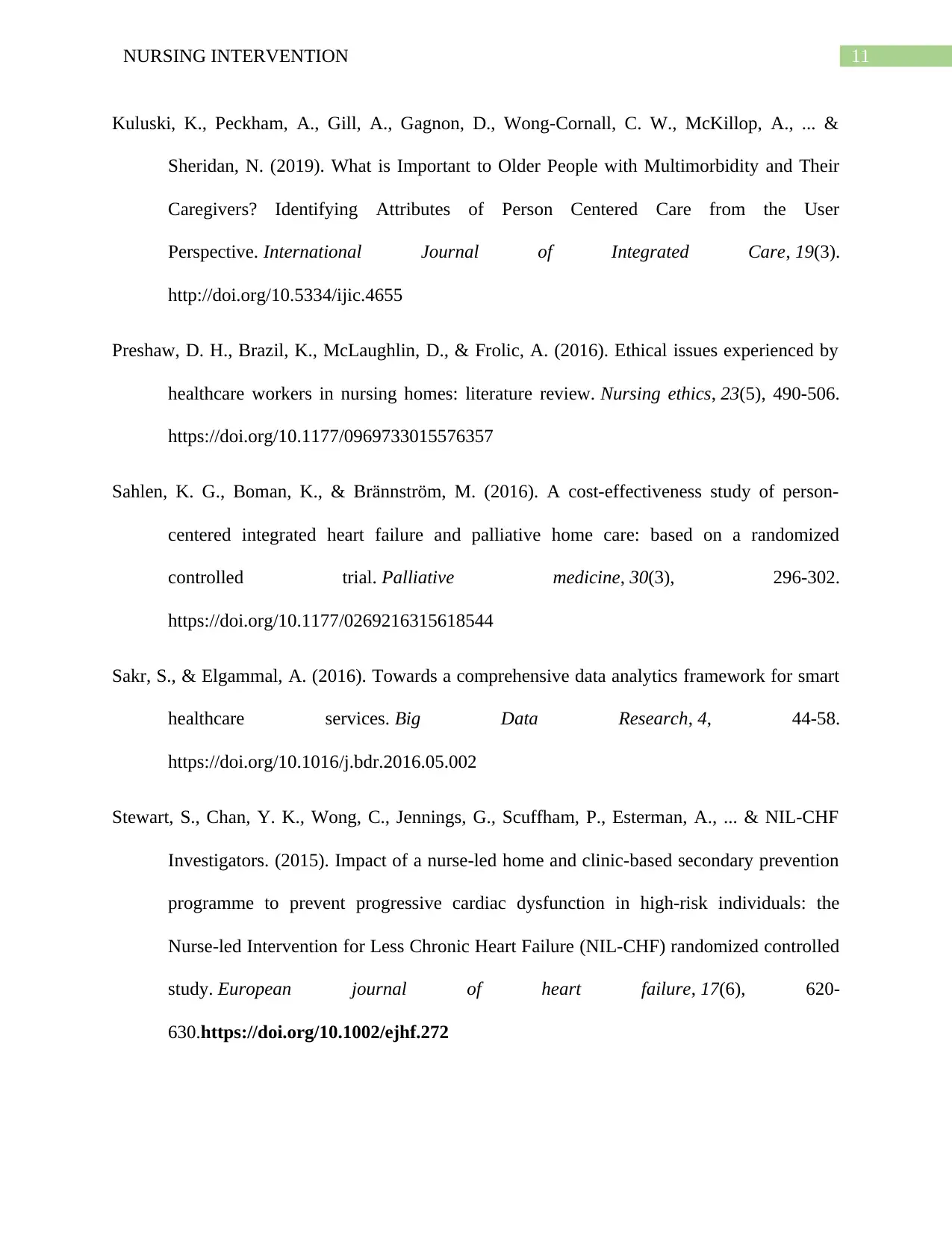
11NURSING INTERVENTION
Kuluski, K., Peckham, A., Gill, A., Gagnon, D., Wong-Cornall, C. W., McKillop, A., ... &
Sheridan, N. (2019). What is Important to Older People with Multimorbidity and Their
Caregivers? Identifying Attributes of Person Centered Care from the User
Perspective. International Journal of Integrated Care, 19(3).
http://doi.org/10.5334/ijic.4655
Preshaw, D. H., Brazil, K., McLaughlin, D., & Frolic, A. (2016). Ethical issues experienced by
healthcare workers in nursing homes: literature review. Nursing ethics, 23(5), 490-506.
https://doi.org/10.1177/0969733015576357
Sahlen, K. G., Boman, K., & Brännström, M. (2016). A cost-effectiveness study of person-
centered integrated heart failure and palliative home care: based on a randomized
controlled trial. Palliative medicine, 30(3), 296-302.
https://doi.org/10.1177/0269216315618544
Sakr, S., & Elgammal, A. (2016). Towards a comprehensive data analytics framework for smart
healthcare services. Big Data Research, 4, 44-58.
https://doi.org/10.1016/j.bdr.2016.05.002
Stewart, S., Chan, Y. K., Wong, C., Jennings, G., Scuffham, P., Esterman, A., ... & NIL‐CHF
Investigators. (2015). Impact of a nurse‐led home and clinic‐based secondary prevention
programme to prevent progressive cardiac dysfunction in high‐risk individuals: the
Nurse‐led Intervention for Less Chronic Heart Failure (NIL‐CHF) randomized controlled
study. European journal of heart failure, 17(6), 620-
630.https://doi.org/10.1002/ejhf.272
Kuluski, K., Peckham, A., Gill, A., Gagnon, D., Wong-Cornall, C. W., McKillop, A., ... &
Sheridan, N. (2019). What is Important to Older People with Multimorbidity and Their
Caregivers? Identifying Attributes of Person Centered Care from the User
Perspective. International Journal of Integrated Care, 19(3).
http://doi.org/10.5334/ijic.4655
Preshaw, D. H., Brazil, K., McLaughlin, D., & Frolic, A. (2016). Ethical issues experienced by
healthcare workers in nursing homes: literature review. Nursing ethics, 23(5), 490-506.
https://doi.org/10.1177/0969733015576357
Sahlen, K. G., Boman, K., & Brännström, M. (2016). A cost-effectiveness study of person-
centered integrated heart failure and palliative home care: based on a randomized
controlled trial. Palliative medicine, 30(3), 296-302.
https://doi.org/10.1177/0269216315618544
Sakr, S., & Elgammal, A. (2016). Towards a comprehensive data analytics framework for smart
healthcare services. Big Data Research, 4, 44-58.
https://doi.org/10.1016/j.bdr.2016.05.002
Stewart, S., Chan, Y. K., Wong, C., Jennings, G., Scuffham, P., Esterman, A., ... & NIL‐CHF
Investigators. (2015). Impact of a nurse‐led home and clinic‐based secondary prevention
programme to prevent progressive cardiac dysfunction in high‐risk individuals: the
Nurse‐led Intervention for Less Chronic Heart Failure (NIL‐CHF) randomized controlled
study. European journal of heart failure, 17(6), 620-
630.https://doi.org/10.1002/ejhf.272
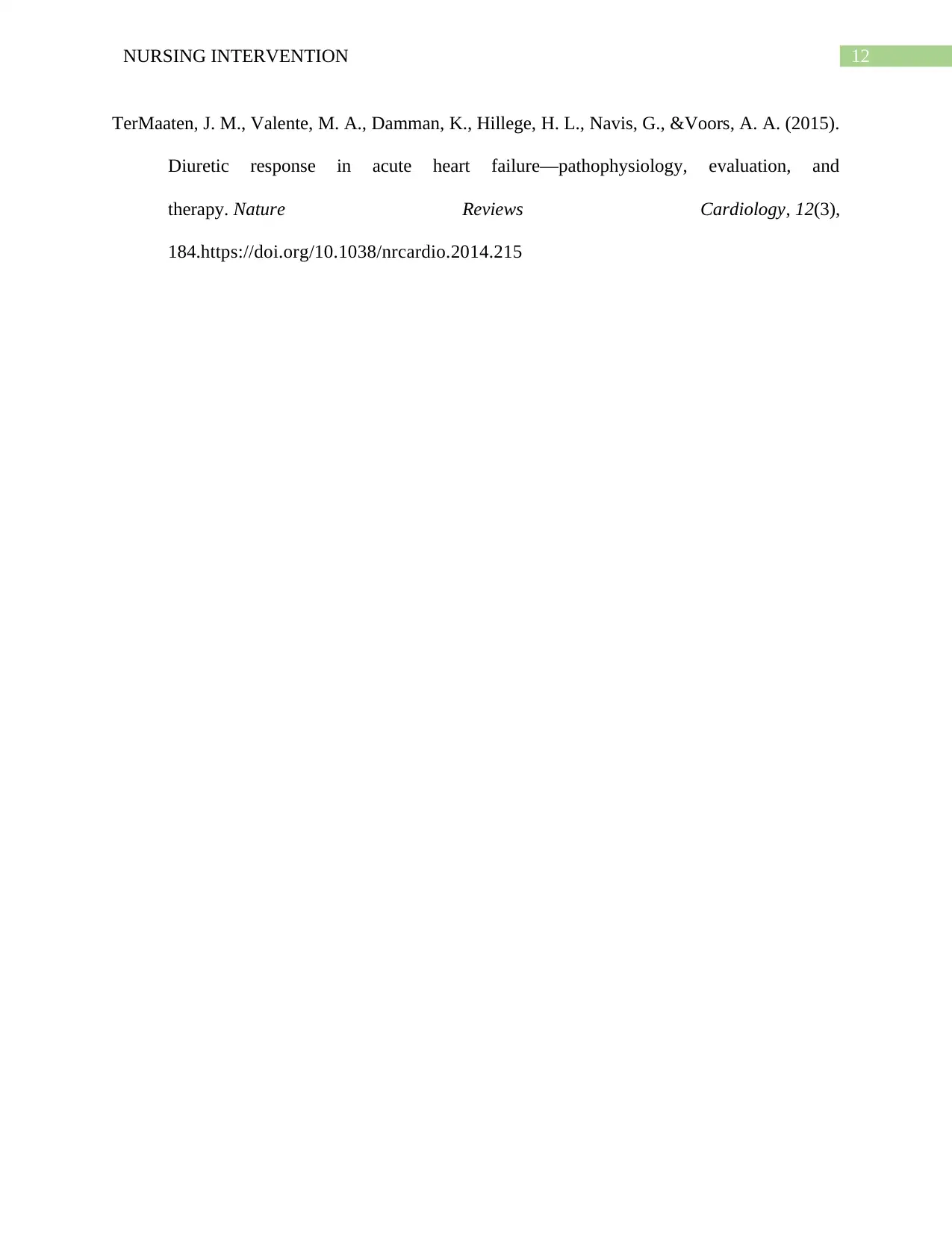
12NURSING INTERVENTION
TerMaaten, J. M., Valente, M. A., Damman, K., Hillege, H. L., Navis, G., &Voors, A. A. (2015).
Diuretic response in acute heart failure—pathophysiology, evaluation, and
therapy. Nature Reviews Cardiology, 12(3),
184.https://doi.org/10.1038/nrcardio.2014.215
TerMaaten, J. M., Valente, M. A., Damman, K., Hillege, H. L., Navis, G., &Voors, A. A. (2015).
Diuretic response in acute heart failure—pathophysiology, evaluation, and
therapy. Nature Reviews Cardiology, 12(3),
184.https://doi.org/10.1038/nrcardio.2014.215
1 out of 13
Related Documents
Your All-in-One AI-Powered Toolkit for Academic Success.
+13062052269
info@desklib.com
Available 24*7 on WhatsApp / Email
![[object Object]](/_next/static/media/star-bottom.7253800d.svg)
Unlock your academic potential
© 2024 | Zucol Services PVT LTD | All rights reserved.





